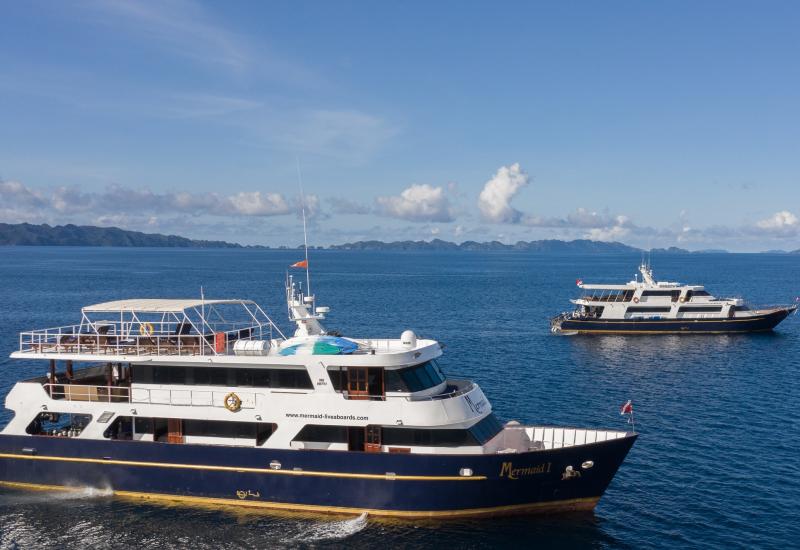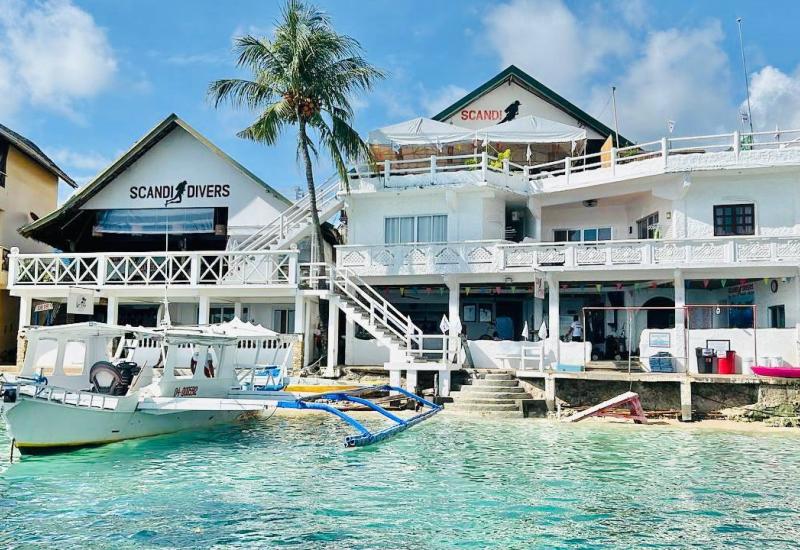Thailand Travel Guide
 |
| A sponge-encrusted overhang in the Mergui Archipelago. |
December 2004
Text and Photography by Stephen Frink
||||
|---|---|---|
|  |
|
| Sea fans and soft corals are colorful complements at many Similan dive sites.|
Shaped like an elephant's head, with a long, slender peninsula forming its trunk, Thailand offers dive opportunities in two distinct bodies of water: the Gulf of Thailand to the east and the Andaman Sea to the west. The Gulf is known for abundant marine life and the laid-back dive hub of Ko Samui, but it's hard to beat the Andaman Sea for clear seas, spectacular reefs and animal encounters. Many divers opt for day trips to the Andaman Sea out of Phuket, an island in the southern reaches of the country, but to get to the sea's unspoiled reefs and islands, live-aboards are a must--and there are literally hundreds of them plying these waters. Perhaps the No. 1 destination for live-aboards is the Similan Islands, a chain of nine granite islands rimmed with white sand beaches. Farther north are the Burma Banks, a series of seamounts rising from 1,000-foot depths to just below the surface, and the Mergui Archipelago. Though part of neighboring Myanmar, the lush Mergui Archipelago is a geologic continuation of the reef structure and islands of the eastern Andaman. For the entire Andaman Sea area, conditions are best between November and March, when you can count on sunny skies, balmy breezes and moderate temperatures.
||||
|---|---|---|
|  |
|
| Regal angelfish|
The Similan Islands, a national park protected under Thai laws, are blanketed in lush tropical jungle and ringed by some of the most exquisite beaches in the country. Among the Similans' top dive sites are East of Eden, where you'll find schools of sweepers densely packed in coral crevices, and The Hideaway, where lionfish and butterflyfish swim along high-profile coral heads. Perhaps the most iconic dive attraction in all the Andaman Sea is Richelieu Rock, in the Surin Islands, due north of the Similans. Richelieu is just a speck on the map, too far offshore for day boats. But for divers on live-aboards, the reward is visibility that can be in excess of 120 feet and stunning biodiversity. Along Richelieu's eastern pinnacle, expect to see sea life in all shapes and sizes, from enormous Malabar grouper to the littlest creatures, such as tiger-tail seahorses and ghost pipefish. Richelieu Rock was once prime whale shark country--a decade ago, operators could nearly guarantee encounters--but sightings have decreased lately. Overfishing in their migratory route seems the obvious culprit.
 |
| The granite formations of the Similan Islands provide a gorgeous backdrop for crystal-clear coves. |
||||
|---|---|---|
|  |
|
| In Thailand, elephants represent power and peace and are a common theme in sculpture and painting.|
Topside, Phuket offers a wealth of attractions, and even the busiest divers should schedule time to explore the island. Don't miss the many Buddhist temples here, well worth visiting for their ornate architecture, statues and colorful murals. Sun worshippers will enjoy Patong Beach, which pulses with activity day and night, and scenic Phang-Nga Bay, where movie fans will recognize "James Bond Island" (so called since 1974's The Man With the Golden Gun was filmed here). And getting around Phuket is a trip in itself, whether you're cruising the coastline in a long-tail boat or enjoying the scenery from the back of an elephant.
||||
|---|---|---|
|  |
|
| Statues wearing the traditional robes of Buddhist monks reflect Thailand's deep spiritual roots.|
The Mergui Archipelago, similar in size to the Bahamas, covers 14,000 square miles and includes about 800 islands, many uninhabited. Wild elephants and tigers are said to roam the larger, more remote islands. While you're likely to run across other dive boats in the Similans, in Mergui there's a sense that you've stumbled into an untouched marine wilderness. A must-dive here is Three Islets, which consists of one small island and two large rocks, each far enough apart to be considered separate sites. The stars of the show are the small creatures, like juvenile ribbon eels, seahorses, and both fimbriated and jeweled morays, often occupying the same hole. Another site, Bang Bang Buffet (so named for all the tank-banging among divers eager to show their buddies the creatures they've discovered) swarms with cuttlefish, black-blotched morays and lionfish. But the real headliners--if something this small can get marquee billing--are the rare rabbit-ear nudibranchs.
Travel Guide
Roughly the size of France, Thailand stretches more than 1,100 miles from north to south and covers about 202,000 square miles. It has two coastlines, one along the Andaman Sea and the other along the Gulf of Thailand.
Water Conditions > In the Andaman Sea, water temperatures are usually warm, ranging from 79 to 84 degrees, though it can be quite a bit cooler at depth, especially during March and April. Water clarity varies from less than 20 feet to 150 feet or more, depending on the season. In general, conditions are best beginning in November. Plankton blooms in March and April drop the vis. Most live-aboards stop operating here from June through October, the southwest monsoon season when vis can be excellent but the seas can be rough, especially at exposed sites. In the Gulf of Thailand, water temps are in the low to mid-80s, with the warmest conditions during May and June. Vis is not as good in the Gulf because of freshwater runoff, plankton and water circulation. The northeast monsoon blows from November through February stirring up the seas and sediment. February through September is generally the best time for diving, when conditions improve.
For More Information > For detailed information on Thailand's dive operators, comprehensive travel guides, special dive deals and recent trip reports submitted by users, click on TripFinder at the top of our home page, www.scubadiving.com.
A sponge-encrusted overhang in the Mergui Archipelago.
December 2004
Text and Photography by Stephen Frink
| Sea fans and soft corals are colorful complements at many Similan dive sites.| Shaped like an elephant's head, with a long, slender peninsula forming its trunk, Thailand offers dive opportunities in two distinct bodies of water: the Gulf of Thailand to the east and the Andaman Sea to the west. The Gulf is known for abundant marine life and the laid-back dive hub of Ko Samui, but it's hard to beat the Andaman Sea for clear seas, spectacular reefs and animal encounters. Many divers opt for day trips to the Andaman Sea out of Phuket, an island in the southern reaches of the country, but to get to the sea's unspoiled reefs and islands, live-aboards are a must--and there are literally hundreds of them plying these waters. Perhaps the No. 1 destination for live-aboards is the Similan Islands, a chain of nine granite islands rimmed with white sand beaches. Farther north are the Burma Banks, a series of seamounts rising from 1,000-foot depths to just below the surface, and the Mergui Archipelago. Though part of neighboring Myanmar, the lush Mergui Archipelago is a geologic continuation of the reef structure and islands of the eastern Andaman. For the entire Andaman Sea area, conditions are best between November and March, when you can count on sunny skies, balmy breezes and moderate temperatures.
Regal angelfish The Similan Islands, a national park protected under Thai laws, are blanketed in lush tropical jungle and ringed by some of the most exquisite beaches in the country. Among the Similans' top dive sites are East of Eden, where you'll find schools of sweepers densely packed in coral crevices, and The Hideaway, where lionfish and butterflyfish swim along high-profile coral heads. Perhaps the most iconic dive attraction in all the Andaman Sea is Richelieu Rock, in the Surin Islands, due north of the Similans. Richelieu is just a speck on the map, too far offshore for day boats. But for divers on live-aboards, the reward is visibility that can be in excess of 120 feet and stunning biodiversity. Along Richelieu's eastern pinnacle, expect to see sea life in all shapes and sizes, from enormous Malabar grouper to the littlest creatures, such as tiger-tail seahorses and ghost pipefish. Richelieu Rock was once prime whale shark country--a decade ago, operators could nearly guarantee encounters--but sightings have decreased lately. Overfishing in their migratory route seems the obvious culprit.
The granite formations of the Similan Islands provide a gorgeous backdrop for crystal-clear coves.
In Thailand, elephants represent power and peace and are a common theme in sculpture and painting. Topside, Phuket offers a wealth of attractions, and even the busiest divers should schedule time to explore the island. Don't miss the many Buddhist temples here, well worth visiting for their ornate architecture, statues and colorful murals. Sun worshippers will enjoy Patong Beach, which pulses with activity day and night, and scenic Phang-Nga Bay, where movie fans will recognize "James Bond Island" (so called since 1974's The Man With the Golden Gun was filmed here). And getting around Phuket is a trip in itself, whether you're cruising the coastline in a long-tail boat or enjoying the scenery from the back of an elephant.
| Statues wearing the traditional robes of Buddhist monks reflect Thailand's deep spiritual roots.| The Mergui Archipelago, similar in size to the Bahamas, covers 14,000 square miles and includes about 800 islands, many uninhabited. Wild elephants and tigers are said to roam the larger, more remote islands. While you're likely to run across other dive boats in the Similans, in Mergui there's a sense that you've stumbled into an untouched marine wilderness. A must-dive here is Three Islets, which consists of one small island and two large rocks, each far enough apart to be considered separate sites. The stars of the show are the small creatures, like juvenile ribbon eels, seahorses, and both fimbriated and jeweled morays, often occupying the same hole. Another site, Bang Bang Buffet (so named for all the tank-banging among divers eager to show their buddies the creatures they've discovered) swarms with cuttlefish, black-blotched morays and lionfish. But the real headliners--if something this small can get marquee billing--are the rare rabbit-ear nudibranchs.
Travel Guide
Roughly the size of France, Thailand stretches more than 1,100 miles from north to south and covers about 202,000 square miles. It has two coastlines, one along the Andaman Sea and the other along the Gulf of Thailand.
Water Conditions > In the Andaman Sea, water temperatures are usually warm, ranging from 79 to 84 degrees, though it can be quite a bit cooler at depth, especially during March and April. Water clarity varies from less than 20 feet to 150 feet or more, depending on the season. In general, conditions are best beginning in November. Plankton blooms in March and April drop the vis. Most live-aboards stop operating here from June through October, the southwest monsoon season when vis can be excellent but the seas can be rough, especially at exposed sites. In the Gulf of Thailand, water temps are in the low to mid-80s, with the warmest conditions during May and June. Vis is not as good in the Gulf because of freshwater runoff, plankton and water circulation. The northeast monsoon blows from November through February stirring up the seas and sediment. February through September is generally the best time for diving, when conditions improve.
For More Information > For detailed information on Thailand's dive operators, comprehensive travel guides, special dive deals and recent trip reports submitted by users, click on TripFinder at the top of our home page, www.scubadiving.com.










